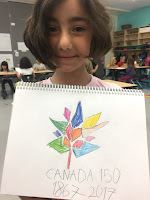Dear Parents/Guardians,
The end of the year is fast approaching and your childs' report cards will be coming home soon! I wanted to post some information and examples of the expectations for the students for the end of grade 1. This is standard across all the grade 1 rooms.
For reading; based on our Fountas and Pinnell assessment system, your child should be reading at a level H/I at the end of grade 1. The assessment is based on decoding (sounding out the words), fluency (expression and pace) and comprehension (does the student understand what they have read and some of the underlying meanings of the text?). They need to be proficient in all 3 areas to be considered 'at' this level. Here is an example of the text you would find in an I level book:
Students may need help with one or two words and their meaning but overall they should be able to read this smoothly and be able to re-tell the important information.
For writing, the students are expected to express ideas and information in a way that is legible and have sentences that make sense. Here is an example of a basic grade-level writing sample (2):
The child uses capitals at the beginning of sentences, periods at the end and spells most common sight words correctly. There are some spelling mistakes but it is easily understood by the reader. The picture matches the writing.
The next sample is a child who would receive a 3 at the end of grade 1. In addition to the expectations above, this child added some more interesting details, started sentences in different ways and used alternate words for descriptive or action words. Notice the use of 'snap' and 'tuck':
Finally here is an example of a 4. The student came up with a story that follows a logical sequence, used interesting vocabulary and started the sentences in different and interesting ways. There is appropriate punctuation and spelling.
To achieve a basic, grade-level mark for math in Number Sense, the student must be able to independently do the following things:
Say the number sequence 0 to 100 by:
- 1s forward between any two given numbers
- 1s backward from 20 to 0
- 2s forward from 0 to 20
- 5s and 10s forward from 0 to 10
- Represent and describe numbers to 20
Identify the number, up to 20, that is:
- one more
- two more
- one less
- two less
- Describe and use mental mathematics strategies for basic addition facts and related subtraction facts to 18
SHAPE AND SPACE
Describe the characteristics of 3-D objects and 2-D shapes, and analyze the relationships among them.
Sort 3-D objects and 2-D shapes, using one attribute, and explain the sorting rule.
Replicate composite 2-D shapes and 3-D objects.
Compare 2-D shapes to parts of 3-D objects in the environment
If your child does not receive a 2 on their report card in an area, we use the language that they are not yet achieving the skill at grade level, because they are working towards it! It does not mean they are 'failing'.
Please, as always, email, call or stop by the classroom if you have any questions regarding the information above or any other concerns or questions and I would be happy to help in any way I can!
Our scientists have been making their observations of our plants each day. We noticed the leaves were doing something very strange...ask me what we noticed in this picture!
We sat with a partner and compared our plants with one another. We used mathematical language such as which plant was shorter or taller. Which leaves were wider or more narrow.
Students had to answer the following questions in their journals, with a detailed, coloured, labeled sketch of their plants
1. My plant has ___ leaves.
2. My plant is _____ than my partners.
3. My plant is ____ cm tall.
Here is how our plants shaped up with our partners!
As a class, we compared our results and found that Mark had the tallest plant in the class with the most leaves. Eldin had the shortest plant with the least amount of leaves.
Lime bean plants are coming home today! Please support your child with taking care of this living thing for as long as they can. They can continue to measure its length and count its leaves. Please ask your child to tell you all of the parts of the plant as well as explain what these plants, like other plants, need to grow. :)
























































